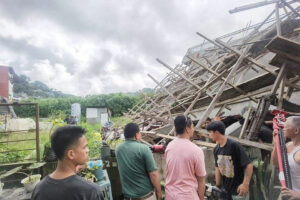DEATHS from the magnitude 7 earthquake that rocked northern Philippines on Wednesday have climbed to 10, according to the local disaster agency.
More 300,000 people from about 82,000 families were affected by the quake, the National Disaster Risk Reduction and Management Council (NDRRMC) said in an 8 a.m. bulletin on Sunday.
The earthquake also damaged more than 21,000 houses, 302 of which were totally destroyed, the agency said.
Damage to infrastructure has reached P414 million in the Ilocos region, Cagayan Valley and Cordillera Administrative Region.
The quake damaged several ancient bell towers, churches and heritage houses as well as cars and other properties in the country’s north.
The tremors were also felt in Manila, the capital and nearby areas, forcing workers to evacuate buildings and halting train operations during rush hour.
The state seismology agency had recorded at least 1,162 aftershocks as 4 p.m. on Sunday the NDRRMC said.
The NDRRMC added that 43 roads and seven bridges got damaged, though cars could now pass through 84% of these.
Electricity to all of the 48 towns that lost power has been restored, while three of four affected areas now had water supply.
Twenty-seven areas have been placed under a state of calamity, the council said.
Meanwhile, agricultural and irrigation damage has climbed to P44.2 million, according to the Department of Agriculture.
Damage and losses were recorded mainly in irrigation systems, farm-to-market roads and other structures.
In the Upper Chico main canal in Tabuk, Kalinga province, four national irrigation systems and two communal irrigation systems were damaged by the quake, according to the National Irrigation Administration.
Pantabangan and Magat dams did not sustain any damage based on initial assessment, it added.
The Agriculture department said it had mobilized two trucks loaded with 2.66 metric tons of assorted highland vegetables, dried fish and other basic food items to municipalities in the province of Abra, where the quake’s epicenter was located.
These included the municipalities of San Quintin, Pidigan, Bangued, Tayum, Dolores, Lagangilang and Bucay.
The country had enough rice buffer stock inventory for immediate relief operations in the northern provinces, the National Food Authority said.
The department was also helping affected farmers and fishers by giving them 126,045 bags of rice seeds, 20,454 bags of corn seeds and 3,379 kilos of assorted vegetable seeds in CAR and the Ilocos, Cagayan Valley and Central Luzon regions.
It added that 1,000 doses of vitamins, 1,000 doses of antibiotics, 500 doses of dewormers and 3,000 doses of vaccines for livestock and poultry had been made available in Cagayan Valley.
The agency said it would fast-track the release of fuel subsidy and cash aid to farmers through the Agricultural Credit Policy Council and Quick Response Fund.
The quake struck about 13 kilometers (km) southeast of the town of Dolores in Abra province at a depth of 10 km on July 27, the US Geological Survey (USGS) said on its website.
Since 1970, 11 other earthquakes of magnitude 6.5 or larger have occurred within 250 km of Wednesday’s earthquake, the USGS said.
The largest of these earthquakes was a magnitude 7.7 earthquake on July 16, 1990 in Baguio City in Benguet, where at least 1,600 people died and more than 3,000 were hurt.
The 1990 earthquake also caused landslides in the Baguio-Cabanatuan-Dagupan area.
The Philippines lies in the so-called Pacific “Ring of Fire,” a belt of volcanoes around the Pacific Ocean where most of the world’s earthquakes strike. — Kyle Aristophere T. Atienza and Luisa Maria Jacinta C. Jocson

